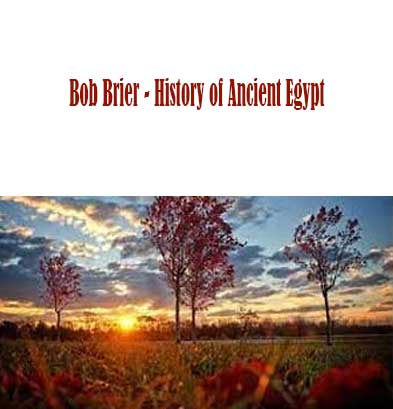Description
Bob Brier – History of Ancient Egypt download, Bob Brier – History of Ancient Egypt review, Bob Brier – History of Ancient Egypt free
Bob Brier – History of Ancient Egypt
History of Ancient Egypt
Chronologically survey the full 3,000 years of recorded ancient Egyptian history led by an Egyptologist and Senior Research Fellow at the C.W. Post Campus of Long Island University.
LECTURE (48)
01:Introduction
What makes ancient Egypt so interesting? How do we know what we know about it? What can you, as a student, expect from these lectures?…
02:Prehistoric Egypt
In this lesson, we will see just how old “old†is. The basic divisions of prehistory will be discussed, and each category will be defined and its specific characteristics delineated. Once these categories are clear, we will discuss the difficulties of studying a prehistoric civilization….
03:Ancient Egyptian Thought
What distinguishes mythology, religion, and philosophy from one another? What role did each play in the lives of the ancient Egyptians?…
04:Napoleon and the Beginnings of Egyptology
Why does modern Egyptology begin with Napoleon? How was Egypt studied before he and his army arrived with 150 scientists in tow in 1798? How did the monumental Description de l’Egypte that Bonaparte’s savants produced become the benchmark for all future publications in the field?…
05:The Rosetta Stone, and Much More
The Rosetta Stone is a large granite stela, carved under Ptolemy V and unearthed by French troops in 1799. With inscriptions of the same text in Greek and Egyptian, it provided the key to deciphering the ancient Egyptian language. Learn the four scripts in which ancient Egyptian can be written, as well as the three ways hieroglyphic signs can be used….
06:The First Nation in History
How did Egypt become history’s first nation? Once King Narmer unified Upper and Lower Egypt, it took only a few hundred years to build a power that would dominate the Near East for millennia. Learn why the political structure of ancient Egypt made this possible and how the “Narmer Palette†tells this story….
07:The Rise of the Old Kingdom
As Egypt becomes a great nation led by a single all-powerful ruler, traditions arise that will last for millennia: a capital city, separate burial places (and eventually mighty pyramids) for the kings, solar boats for the trip to the next world, and more….
08:Sneferu, the Pyramid Builder
This lecture will present a portrait of the founder of the “Fabulous Fourth†Dynasty, Sneferu. Using trial and error, he figured out how to build a true pyramid. His reign also saw Egypt’s blossoming as an international power and the setting of artistic standards that would last for thousands of years….
09:The Great Pyramid of Giza
From leveling the foundation to setting the capstone, here are-as best as we can make out-the “nuts and bolts†of the Egyptians’ most literally “monumental†feat: pyramid building. This lecture also discusses the 144-foot solar boat that was found in 1954, buried near the Great Pyramid….
10:The End of the Old Kingdom
After the fantastic achievements of Dynasty IV, something-no one knows what-changed. Pharaohs stopped building pyramids and seem to have adopted sun worship. Dynasty VI resumed pyramid building on a small scale, but the death of its last king plunged Egypt into chaos….
11:The First Intermediate Period
After centuries of power, pyramids, and prosperity, Egypt totally collapsed. Why? A look at this period also shows the methods that Egyptologists use to reconstruct history where the resources are scant….
12:The Middle Kingdom-Dynasty XI
The Middle Kingdom is the story of Egypt’s resurrection. Dynasty XI is the dynasty of reunification, slowly bringing Egypt back to unity and greatness….
13:The Middle Kingdom-Dynasty XII
The seven kings of Dynasty XII built pyramids, fostered great literature (often for political purposes), and consolidated power once again in the center….
14:The Second Intermediate Period
Ancient Egypt is the only civilization in history to have been eclipsed twice and bounced back to prominence on both occasions. Dynasties XIII through XVII saw the Middle Kingdom’s decline, the advent of foreign rule, and finally, the expulsion of the Hyksos by a heroic prince of Thebes and his two sons at the end of Dynasty XVII….
15:Joseph in Egypt
The Bible describes a lengthy sojourn of the Israelites in Egypt. We examine the Joseph story in the Book of Genesis to see what light Egyptology might shed on its authenticity….
16:The Beginning of the New Kingdom-The Fabulous XVIIIth Dynasty
Practices we think of as defining ancient Egypt-including the use of a standing army to exact foreign tribute and the burial of the pharaohs in the Valley of the Kings-have their origins in this seminal period. We will also take a detailed look at what warfare was like in the ancient world….
17:Queen Hatshepsut
One of the greatest individuals in Egyptian history, Hatshepsut appears in no official Egyptian record. When she died, she was “King of Upper and Lower Egypt.†How did she handle the three core activities of kingship-building, warfare, and trading expeditions? Why was her name later systematically expunged?…
18:Obelisks
Obelisks are a purely Egyptian invention. Quarrying, transporting, and erecting one is perhaps an even greater engineering feat than the building of a pyramid. Learn the origins and religious significance of obelisks….
19:Tuthmosis III-King At Last
For 22 years, Tuthmosis III was second fiddle to his aunt Hatshepsut, who ruled as a king although she was a woman. When she died and he ruled by himself, he became one of the greatest military pharaohs Egypt had ever known. Learn what it meant to be a great king by tracing the epic events of his reign….
20:The Fabulous XVIIIth Dynasty Rolls On
Witness this glorious dynasty continue through two superior pharaohs and then one great one, Amenhotep III, “The Sun King.â€â€¦
21:Akhenaten the Heretic Pharaoh
The most enigmatic and controversial pharaoh in Egypt’s history, Akhenaten rocked the pillars of Egyptian society. He may have been the first monotheist and the first “individual†in history….
22:The Discovery of Tutankhamen’s Tomb
Unearthed by Howard Carter in 1922, the burial place of this young son of Akhenaten is the only royal tomb to have been found substantially intact. Follow the careful research and planning that led up to Carter’s discovery, and learn the significance of the thousands of artifacts found….
23:The Murder of Tutankhamen-A Theory
Was Tutankhamen the victim of foul play? Do his mummified remains hold clues? Who might have wanted him dead, and why? Sift the physical and circumstantial evidence for this intriguing hypothesis and form your own conclusion….
24:Medicine-The Necessary Art
The physicians of Egypt were famous throughout the ancient world. Probe the justification for this fame by examining medical papyri. We will see that there were really two approaches to medicine: clinical and magical….
25:The End of Dynasty XVIII
What happened when a pharaoh died without issue? Find out by looking at three such cases that arose toward the end of Dynasty XVIII. Tutankhamen, Aye, and Horemheb, the last king of the dynasty, left no children….
26:Mummification-How We Know What We Know
Mummification was a trade secret. The Egyptians left no records of how they did it. Detective work is needed, and fortunately, there are four papyri that offer some clues….
27:What Mummies Tell Us
The primary source for figuring out how the Egyptians mummified their dead is the mummies themselves. What distinguishes mummies from the Old Kingdom, the New Kingdom, and the Late Period, respectively? How have Egyptologists reconstructed this ancient art? By the end of this lecture, you will be able to look at a mummy and tell how old it is….
28:Making a Modern Mummy
Here you’ll learn how Professor Brier mummified a human cadaver in the ancient Egyptian manner to determine how the Egyptian embalmers did it. The purpose of the project was not to make a mummy, but to gain knowledge of the instruments, substances, and surgical procedures used during the process….
29:Dynasty XIX Begins
After three childless pharaohs in a row, Egypt desperately needed stability. Thus, the first pharaoh of Dynasty XIX may have been selected not for his ability, but because of his heirs!…
30:Ramses the Great-The Early Years
Ramses the Great ruled for 67 years and was considered one of Egypt’s greatest pharaohs. The pillars of his reputation were classic: warfare and building….
31:Ramses the Great-The Later Years
There is a bit of a mystery about Ramses’s reign. Its last 40 years were rather sedentary. In considering what might have happened, you will see how a pharaoh with the resources of Ramses prepared himself and his family for the next world….
32:The Exodus-Did It Happen?
The Book of Exodus, so fundamental to the history of the Jewish people, is the section of the Old Testament most closely tied to Egypt. What light can Egyptology shed on the biblical account?…
33:The Decline of Dynasty XIX
Short reigns and a lack of major building projects betray the beginnings of Egypt’s long slide from greatness….
34:Dynasty XX-The Decline Continues
After Ramses III’s brief attempt to restore Egypt’s stability, the downward slide continued. Who were the mysterious Sea Peoples? How did they contribute to the weakening of Egypt?…
35:Ancient Egyptian Magic
Magic was a central concern of the ancient Egyptians. What were its basic elements and practices?…
36:Dynasty XXI-Egypt Divided
Egypt’s long slide continued as rival dynasties ruled from Thebes and the Delta. Egyptian history had become “a tale of two cities.â€â€¦
37:Dynasty XXII-Egypt United
Libyans ruled from the Delta city of Bubastis for 200 years and fought to restore Egypt’s greatness. During this time, Egypt became involved with the biblical kingdoms of Judah and Israel. In the end, Egypt suffered division once more, but this time the two halves did not fight one another….
38:Dynasty XXV-The Nubians Have Their Day
Nubians had been permitted to grow independent, with their leaders taking the title of pharaoh. They were also devoted to Amun, so in a sense, Egypt was their spiritual home. We will see a warrior from the south (Kush) battling a confederation of Egyptian “kings†and unifying Egypt once again….
39:Dynasty XXVI-The Saite Period
Egypt fell under and then escaped Assyrian control only to face a new menace in the form of Babylon. As if they knew it was the last gasp, the pharaohs of Dynasty XXVI looked back to the Old Kingdom for inspiration….
40:Dynasty XXVII-The Persians
The Greek traveler Herodotus gives three different reasons Persia invaded Egypt. How do his accounts compare with Egyptian records? How did Egypt express its unbending will to be free under this latest group of foreign rulers?…
41:Dynasties XXVIII to XXXI-The Beginning of the End
Four very brief dynasties ruled in succession. When the last native-born ruler, Nectanebo II, was forced to flee into Nubia, Egypt’s glory was over….
42:Alexander the Great
Alexander the Great began 300 years of Greek control of Egypt. We will trace his extraordinary career as a young general, as pharaoh, and as legendary conqueror….
43:The First Ptolemies
The Greek kings known as the Ptolemies ran Egypt like a business. Taxes were heavy; government was oppressive. There are two great Hellenistic achievements, however: the Pharos Lighthouse and the famed Library of Alexandria….
44:The Middle Ptolemies-The Decline
A TV show about the Middle Ptolemies might well be called “Lifestyles of the Rich and Murderous.†With few exceptions, the members of this dysfunctional dynasty were violent, debauched, and generally neglectful of the country they ruled. The Egyptians hated them and frequently rebelled, forcing some to flee for their lives. With each Ptolemy, Egypt sank deeper, making a return to greatne…
45:Animal Mummies
The Ptolemies had a fascination with mummies, especially animal mummies. We will take an in-depth look at the practice of animal mummification, which became a major industry during the Ptolemaic period….
46:Cleopatra’s Family
For a Ptolemy, dodging assassination by one’s own kin was often the hardest part of ruling. Learn how Cleopatra’s father managed this task, and trace the course of Egypt’s growing-and ultimately fatal-interaction with the rising power of Rome….
47:Cleopatra-The Last Ptolemy
Although Cleopatra is one of the most famous women who ever lived, she remains an enigma-we don’t even know her mother’s name. History is written by the victors, and Cleopatra lost. Can ancient records help fill out her story?…
48:The Grand Finale
This last lecture crowns the course by briefly summarizing 3,000 years of Egyptian history; outlining Egypt’s legacy to us; surveying images of Egypt in film and literature; and listing ways you can pursue your interest in this remarkable civilization. Your learning needn’t stop here!…
DETAILS
Overview
Ancient Egyptian civilization is so grand that our minds sometimes have difficulty adjusting to it. If you’re awed by the Great Pyramid, amazed by the magnificent golden mask and other treasures of Tutankhamen, curious about how this longest-lived of all ancient cultures has influenced us, or just intrigued by the mysterious hows and whys of all things Egyptian, then you must own this comprehensive and entertaining course by one of our most popular professors.
About
Bob Brier
“To a great extent, the fun of history is in the details. Knowing what kind of wine Tutankhamen preferred makes him come alive.â€
ALMA MATERÂ The University of North Carolina, Chapel Hill
INSTITUTIONÂ Long Island University
Dr. Bob Brier is an Egyptologist and Senior Research Fellow at the C.W. Post Campus of Long Island University. He earned his bachelor’s degree from Hunter College and Ph.D. in Philosophy from The University of North Carolina at Chapel Hill. Professor Brier has twice been selected as a Fulbright Scholar and has received Long Island University’s David Newton Award for Teaching Excellence in recognition of his achievements as a lecturer. He has served as Director of the National Endowment for the Humanities’ Egyptology Today program. In 1994, Dr. Brier became the first person in 2,000 years to mummify a human cadaver in the ancient Egyptian style. This research was the subject of a National Geographic television special, Mr. Mummy. Dr. Brier is also the host of The Learning Channel’s series The Great Egyptians. Professor Brier is the author of Ancient Egyptian Magic (1980), Egyptian Mummies (1994), Encyclopedia of Mummies (1998), The Murder of Tutankhamen: A True Story (1998), Daily Life in Ancient Egypt (1999), and numerous scholarly articles.








